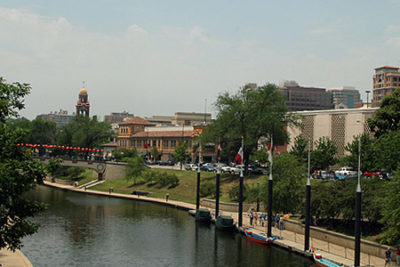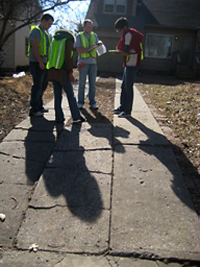Every Drop Counts – The Greening of Our Sewers
By Dr. Deb O’Bannon, Associate Professor of Civil Engineering at UMKC School of Computing and Engineering
Engineers design useful things, and more specifically, civil engineers design projects that benefit the general public. So, getting deeply involved in Kansas City’s stormwater and combined sewer solution was a natural extension of my role as a UMKC civil engineering professor.
Together with representatives from the general public and the Kansas City Water Services Department, I participated as a local expert, along with UMKC’s Dr. Ray Coveney, UMKC Professor of Geosciences, on the Wet Weather Community Panel. The panel, which met from September 2003 to December 2008, discussed possible engineering solutions for local weather-related problems, especially problems affecting residents and business owners.
Solutions to correct or reduce the effects of combined sewer overflows can be expensive and extremely inconvenient. Digging up every street to install separate stormwater and sewer pipes is a terrible disruption to residents and businesses, and has other hidden complications because of buried utilities. More traditional solutions, which will also be employed in Kansas City, include larger pipes, underground storage and increased capacity at the wastewater treatment plant, which are termed “grey solutions,” referring to the concrete and steel. What are other options?
One approach is to modify the classic recycling motto, reduce-reuse-recycle to become reduce-delay-recycle for stormwater. Reduce in this motto means reducing the quantity of stormwater that gets to the sewer inlets by disconnecting downspouts, and installing rain barrels and green roofs. Delay means storage and controlled release. Such a release helps the sewer system to dodge the peak flow, which overloads the system, and to release stormwater slowly into the system for treatment. Recycle means creating opportunities for the rainfall to soak into the ground. Green spaces, rain gardens and porous pavement also serve to delay or recycle, depending on the design. These efforts are called “green solutions.” We remind people that Every Drop Counts.
A USEPA-funded project quantitatively measures the effectiveness of this reduce-delay-recycle strategy for Kansas City conditions. Why Kansas City? Our municipality must ameliorate the effects of combined sewer overflows, and the Midwest has high-intensity rain storms and low-permeability clay soils. Other performance studies of green solutions for stormwater mitigation were done in areas with gentle rainfall and more permeable soils. Our natural conditions, combined with small lot sizes and compacted soils, make the USEPA demonstration project, bounded by 75th Street, 79th Street, Troost Avenue and Paseo Boulevard, a “perfect storm” for measuring the effectiveness of green solutions.
UMKC is providing on-the-ground monitoring for the demonstration project. My group’s responsibilities include flow monitoring, water quality monitoring, soil infiltration studies, lot and street assessments, rain gauging and performance measures of the green solutions. These represent real implementations in a real neighborhood. Consequently, in addition to the ongoing surveys [see photograph above], we also attend neighborhood association meetings, and meetings focused on the project hosted by Cindy Circo, Councilwoman for the 5th District. The other participants of the USEPA project are TetraTech (project management), Mid-America Regional Council (communications and education), University of Alabama (Dr. Bob Pitt, a nationally-recognized green solutions expert) and Bergmann Associates (modeling).
A parallel effort to the USEPA demonstration project is a weekly radio program on KCMO 710 AM. I host Water, Water Everywhere, a talk show aiming to educate the public on the reasons for and implications of water projects, to share water-related success stories in an effort to help build confidence in engineering decisions, and to highlight the qualifications of the engineers and decision-makers. The first show aired in January 2009 and is currently sponsored by the Water Pollution Control Department of Independence, Missouri; the Water Services Department of Kansas City, Missouri; and the UMKC School of Computing and Engineering.
Read about Dr. O’Bannon and her work at her Web site.


